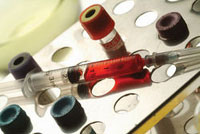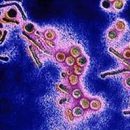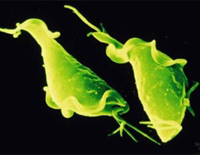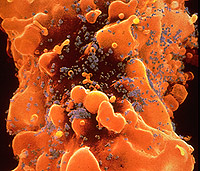What are the methods of diagnosis of toxoplasmosis? How to prevent toxoplasmosis? Read in this article.
Content
Toxoplasmosis
 Toxoplasmosis - Widespread human and animal disease. In confirmation of this, we give the fact that up to 70% of the population can be infected with toxoplasm, and 50% is almost normal. At the same time, 99.99% from among those infected were never experienced, they are not experiencing and hardly ever something bad in this regard will experience.
Toxoplasmosis - Widespread human and animal disease. In confirmation of this, we give the fact that up to 70% of the population can be infected with toxoplasm, and 50% is almost normal. At the same time, 99.99% from among those infected were never experienced, they are not experiencing and hardly ever something bad in this regard will experience.
Real, really real, really probable and very (!) a serious danger of toxoplasmosis presents when a woman previously not in contact with toxoplasma is infected during pregnancy. This danger applies not to a pregnant woman, but on the fruit. Toxoplasm can penetrate the placenta and cause illness in a non-born child. The severity of the fetus lesion is closely related to pregnancy time - than younger the fetus, the hardest disease, which is called congenital toxoplasmosis. The severity of the disease (especially in infecting in the first three months of pregnancy) is so great that the fetus death occurs. But more often the child is born with very heavy lesions of the nervous system (primarily brain), eye, liver, spleen.
The fact that the permeability of the placenta for toxoplasm changes - it (permeability) is higher, the higher the longer the term of pregnancy. So, when infected in the first three months of pregnancy, the likelihood that the placenta «will not cope» and toxoplasm will hit the fruit, is about 15%. In the second trimester, risk increases to 25%, in the third - almost up to 70%.
Congenital toxoplasmosis
Congenital toxoplasmosis has different forms, sometimes its manifestations after the birth of a child are missing (more precisely, not found), and in the future violation of vision and mental retardation (often very pronounced) arrange sad diagnostic points over I.
If a woman is diagnosed during pregnancy, a toxoplasma is diagnosed, then emergency treatment is carried out. But congenital toxoplasmosis is very tragic in its consequences. And, oddly, any treatment only reduces the likelihood of extremely severe fetal damage (about twice), but it does not guarantee that everything will be fine. Chances to give birth to a full-fledged person very little - hands and feet in such a child will be, but hopes for intact brain and normal eyes almost do not.
Only the fact that the toxoplasmotic damage of the fetus can happen only once (only with one pregnancy). All subsequent children will already be reliably protected by the resulting antibodies.
It is not surprising that toxoplasmosis in pregnant women, taking into account the full futility of the treatment of the child born, is considered as a direct indication for its (pregnancy) interruption, of course, with the consent of the most pregnant.
Nature and itself actively care for birth to prevent: with early infection almost always miscarriage. But now, in the threat of a breakdown, doctors can save almost any pregnancy, and from here it is very important that against the background of treatment and the corresponding examination.
Methods of diagnosis of toxoplasmosis
 The examination is generally a separate topic, for the number of stresses and threats of a breakdown, which arose due to improper interpretation of the results - amazingly great.
The examination is generally a separate topic, for the number of stresses and threats of a breakdown, which arose due to improper interpretation of the results - amazingly great.
But in fact, everything is not so difficult.
A variety of diagnostics of toxoplasmosis has been developed, but an immuno-immunimen analysis (IFA) is most reliable. The essence of this method is to determine the specific antibodies to the toxoplasm, while not only the answer to the question is, they are (antibodies) or not, but also determined them (antibodies).
In order to properly understand the results of the ELISA, it is not necessary to own particularly complex knowledge from the field of physiology. The fact is that immediately after infection, the body begins to produce special antibodies (immunoglobulins), which are called IGM (or - otherwise - early antibodies). Preserved (and detected) they are in the blood maximum during the year, but, as a rule, it is less, and then disappear to no longer appear. Following IGM in blood, IgG appear, which are preserved throughout the subsequent human life.
It is easy to figure out that:
- If Igm is found, then the man has become infected quite recently;
- If IgG is found, but IGM is missing, then it is that a person has already developed immunity to toxoplasm, since the infection occurred in the past;
- Options are possible and more complex for interpretation. For example, an IgG and a small amount of Igm detected. In this case, the study is repeated after 2 weeks, and if the amount of IgG increased, it means that the active development of immunity continues, if it remains at the same level - it means that the disease is already in the past (just in not very distant past).
The interpretation of the results of an immunoferment analysis in newborns has its own specifics, but, in turn, allows you to answer the question of the availability or absence of congenital toxoplasmosis.
Theoretically in civilized society pregnancy - the phenomenon is planned. And survey on toxoplasmosis «before» - very desirable and very appropriate. For the intensity of preventive measures is very dependent on which relations with toxoplasma is the body of the future mother.
If IgG is found, it is a reason to breathe with relief, because during pregnancy the fruit will be securely protected. If Igm - «Fresh» infection, with conception to wait. If antibodies are not detected - to be careful, firmly assimilate the events, to prevent infection and strictly observe them.
Prevention of toxoplasmosis
Unfortunately, in our geographical space, pregnancy planning is rather an exception than the rule. But know and understand the meaning of the results described above does not prevent and during pregnancy already held. Only here, when IGM is detected, it will not have to wait, but to take very responsible and often very unpleasant solutions.
The preventive measures mentioned by us are generally obvious and logically derive from the already described methods of infection. At the same time, their listing may not be completely superfluous (which, by and large, is fair to any infection):
- Exclude from food thermally untreated meat;
- Do not try raw minced;
- I did not regret soap and time, wash your hands after working with meat, after work in the field-garden;
- Most thoroughly wash vegetables fruits, greens;
- examine and, if necessary, to treat, and even easier - remove the cat from home.
This, so to speak, individual preventive measures that make no immunity to protect the fruit during pregnancy. At the same time, more global actions are relevant and aims to reduce the spread of toxoplasm in nature. These are the most closely associated with cats. The latter are divided into home and street. Homely treasure and examine, streets are caught and, despite the protests of animal lovers, try to eliminate both class.
With respect to homemade Murca - it is useful to exclude from the diet of raw meat, is desirable (obligatory) regular disinfection of its sandile toilet.
Since the final eradication of street cats is unlikely, pay attention to the children's sandbox. Theoretically, sanitary supervision authorities are required to regularly explore and disinfect sand, but more correctly do not hope on aunt in a white coat, but to organize a sandbox cover with a plastic film or wooden shields (when children appeared and the absence of cats, the coating can be removed).
A few words about treatment. Some drugs (antibiotics, sulfonamides, etc.) have a pronounced activity in relation to toxoplasmas. The amount of drugs is not particularly large, but the choice, however, is. And for humans, and animals have developed appropriate treatment regimens, which is usually long-term - several courses are used and certain combinations of drugs.
The effectiveness of treatment is high only in acute toxoplasmosis, but leaves much to be desired (to put it mildly) with chronic infection, concomitant immunodeficiency, intrauterine infection.
From here and implies the urgent need to think more often about the actions of preventive. For the terrible toxoplasmosis is terrible in their consequences, it is surprisingly easily prevented, and it is necessary for this very little - wanted to get information and comply with the elementary personal hygiene rules.









